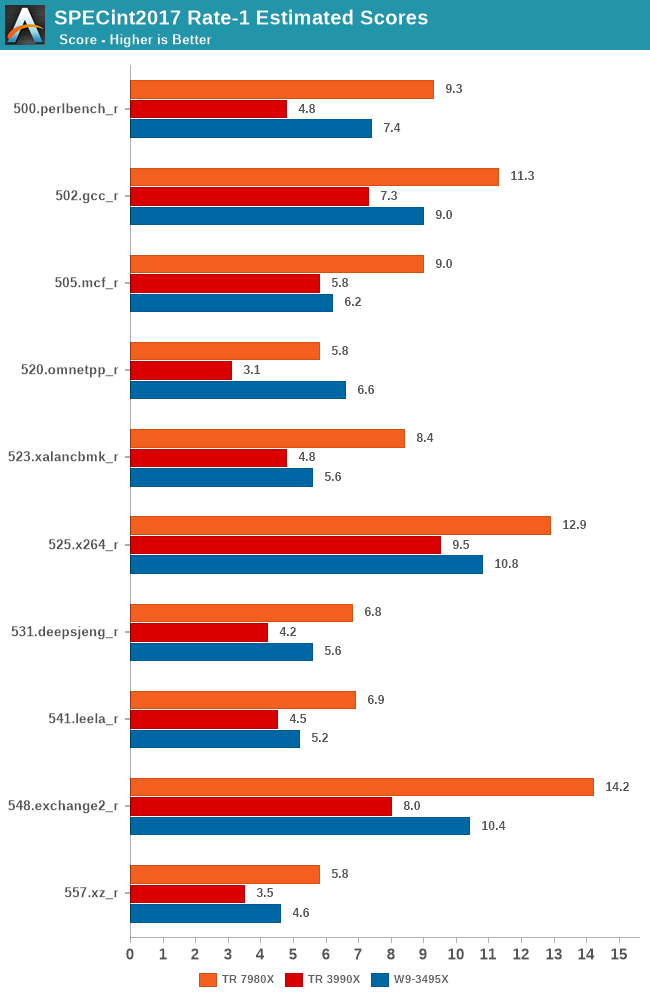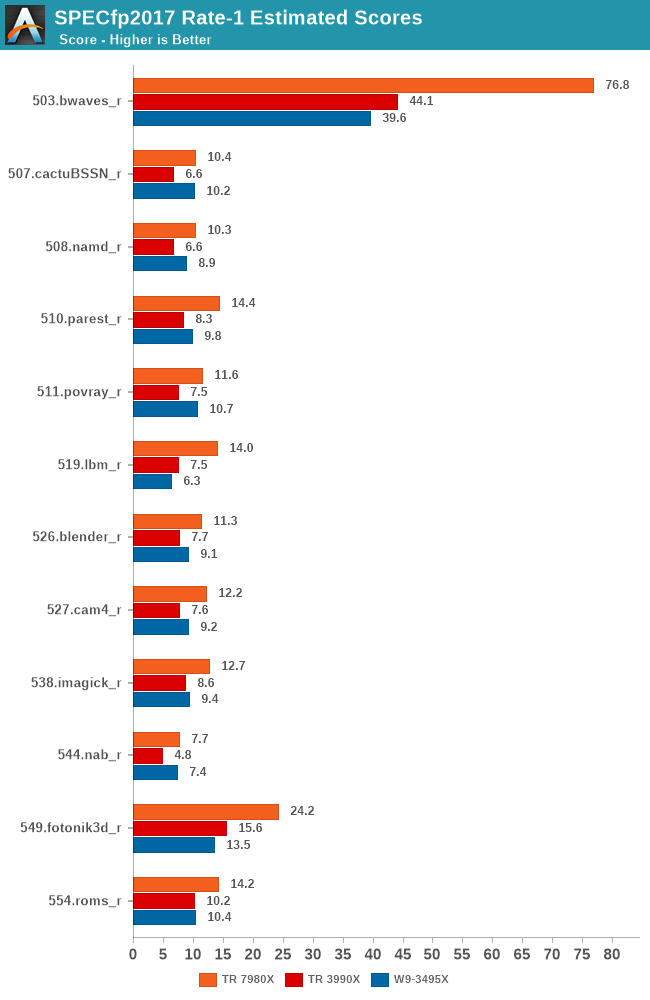AMD Ryzen Threadripper 7980X & 7970X Review: Revived HEDT Brings More Cores of Zen 4
by Gavin Bonshor on November 20, 2023 9:00 AM EST- Posted in
- CPUs
- AMD
- HEDT
- ThreadRipper
- Zen 4
- Threadripper 7000
- TRX50
SPEC2017 Single-Threaded Results
SPEC2017 is a series of standardized tests used to probe the overall performance between different systems, different architectures, different microarchitectures, and setups. The code has to be compiled, and then the results can be submitted to an online database for comparison. It covers a range of integer and floating point workloads, and can be very optimized for each CPU, so it is important to check how the benchmarks are being compiled and run.
We run the tests in a harness built through Windows Subsystem for Linux, developed by Andrei Frumusanu. WSL has some odd quirks, with one test not running due to a WSL fixed stack size, but for like-for-like testing it is good enough. Because our scores aren’t official submissions, as per SPEC guidelines we have to declare them as internal estimates on our part.
For compilers, we use LLVM both for C/C++ and Fortan tests, and for Fortran we’re using the Flang compiler. The rationale of using LLVM over GCC is better cross-platform comparisons to platforms that have only have LLVM support and future articles where we’ll investigate this aspect more. We’re not considering closed-source compilers such as MSVC or ICC.
clang version 10.0.0
clang version 7.0.1 (ssh://git@github.com/flang-compiler/flang-driver.git
24bd54da5c41af04838bbe7b68f830840d47fc03)
-Ofast -fomit-frame-pointer
-march=x86-64
-mtune=core-avx2
-mfma -mavx -mavx2
Our compiler flags are straightforward, with basic –Ofast and relevant ISA switches to allow for AVX2 instructions.
To note, the requirements for the SPEC licence state that any benchmark results from SPEC have to be labeled ‘estimated’ until they are verified on the SPEC website as a meaningful representation of the expected performance. This is most often done by the big companies and OEMs to showcase performance to customers, however is quite over the top for what we do as reviewers.

Opening up our performance analysis of the Ryzen Threadripper 7980X in SPEC2017 1T, as we typically do, we split the results between SPECint2017 and SPECfp2017. Starting with SPECint2017, we can see clear gains in the Ryzen Threadripper 7980X (Zen 4) compared to the previous Threadripper 3990X processor (Zen 2). Given the generational gap between the two core architectures, AMD never released regular HEDT-focused Zen 3 Threadripper processors.
In the majority of our tests, we're seeing single-threaded performance gains of between 65 and 93% within the 500.perlbench_r test of the SPECint2017 1T suite provided the largest gain in ST performance we saw. Looking at how the Intel Xeon W9-3495X performed in SPECint2017, lower single-threaded performance is expected due to the slower core frequencies, and our data shows this. It still puts it ahead of the Ryzen Threadripper 3990X in each scenario, but the Ryzen Threadripper 7980X performs best of all.

Focusing on the second half of our SPEC2017 1T suite, the SPECfp2017 section, we can see that although the performance gap between the Threadripper 7980X isn't as big as SPECint2017 1T, it still represents solid generational gains over the 3990X. The SPECfp2017 1T section of the suite also puts the Intel Xeon W9-3495X closer to the older Threadripper 3990X, which can, again, be explained due to the much slower core frequencies, e.g., 1.9 G base, 3.4 G turbo vs. 2.9 G base, 4.3 G turbo.
Overall, in SPEC2017 1T, the AMD Ryzen Threadripper 7000 represents significant single-threaded gains over the Threadripper 3990X, but we expected this given the generational jump between the two processors.










66 Comments
View All Comments
Jansen - Monday, November 20, 2023 - link
Bit disappointing that the memory controller only supports DDR5-5200, considering that JEDEC compliant DDR5-6400 RDIMMs are available.Ryan Smith - Monday, November 20, 2023 - link
At the end of the day it's the same I/O die as Genoa. So it comes with roughly the same restrictions.TEAMSWITCHER - Monday, November 20, 2023 - link
Not surprised by this at all. My 3960X Threadripper system was never able to run 64gb (16gb x 4) at even the promised DDR4-3200 speed. I tried three different RAM kits and even a different CPU (replaced by AMD) and the problem never went away. In the end I believe it to be motherboard issue, it was simply incapable of running stable with any RAM faster than DDR-3000.After spending so much on the ASUS Zenith II Extreme Alpha motherboard, 64GB of DDR-3600 RAM, and a $1400 CPU, the end result was very disappointing. Support from ASUS, AMD, and G-Skill was a long process, and eventually I had to just accept what was working and move on.
Ultimately, I don't believe that AMD and ASUS can properly deliver and support any HEDT platform that is worth the money they ask for it. I sincerely wish Intel would return to this segment, as I never had a problem with my X99 Deluxe II motherboard.
lemans24 - Monday, November 20, 2023 - link
Intel is definitely in HEDT with their xeon w-2400 chipsStormyParis - Monday, November 20, 2023 - link
I've blacklisted Asus. Lots of issues with both specs, reliability, and service.vfridman - Monday, November 20, 2023 - link
I have two systems with 3990X and two systems with 3970X, ASUS Zenith II Extreme Alpha motherboard and 256GB of 3600 speed G.Skill RAM in each system. All runs perfectly and completely stable, even with maxed out PBO overclock. I regularly run compilation jobs that require almost entire 256GB of RAM and never experienced any problems. I suspect you got unlucky with your CPU memory controller.Mikewind Dale - Tuesday, November 21, 2023 - link
I have a ThreadRipper Pro 3950X on a Supermicro WRX80 motherboard. I run 8x64 (512) GB of Supermicro-branded DDR4 3200 ECC RDIMM without a problem.Adam7288 - Wednesday, November 22, 2023 - link
Same exact config! Ram Bros.tygrus - Saturday, January 6, 2024 - link
How are you going with those >200GB matrices & statistics?Many years ago I had to use raw frequency stats, then a program to generate blocks of SAS code that could analyse cross-tab by cluster (weighted) with smaller subsets of interest from every possible combination (multi-morbidity data). Making sure the stats methods still gave correct results. Divide & conquer to fit in limited RAM of circa 2013 computers. In those days it was mostly constrained by single thread & disk/network IO speed (~100MB/s).
TEAMSWITCHER - Friday, November 24, 2023 - link
Ya know.. I have yet to build an AMD system that didn't suffer from some kind of issue. I don't think I'm unlucky either. I need to stop buying AMD gear thinking... "this time will be different." Because it never is.